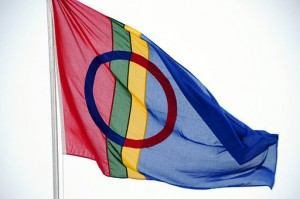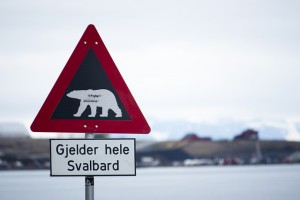The Scotlands of Norway Posted by Bjørn A. Bojesen on Sep 27, 2014 in Norway and the world

The Saami flag. By anjči from London, UK (Saami flag, Tromsø / Norway) [CC-BY-2.0], via Wikimedia Commons
– Sápmi (Saami) or Sameland (Norwegian) is the ”Saami Country”. Samene (the Saami people) probably came to Norway long before the Vikings. I gamle dager (in days of old) there were Saami living as far south as Sørnorge (Southern Norway). The Norwegians, however, gradually pushed them north. Today they are living in parts of Nordnorge (Northern Norway, mainly the fylker Finnmark, Troms, Nordland and a bit into Trøndelag). Many Saami have kept their ancient clothing, singing and herding traditions (reinsdyr! reindeer!), and even the language samisk (Saami), which is related to Finnish. They used to be discriminated by Norwegian officials, such as lærere (school teachers) who would brutally punish Saami schoolchildren who were caught speaking their own language. Today they’re of course (!) fully integrated into the Norwegian society and even have the right to wave little Saami flags on 17. mai, den norske grunnlovsdagen (the day of the Norwegian constitution). The Saami have their own parliament – Sametinget – in the Saami-speaking town of Karasjok. For two reasons, though, it’s very unlikely that there’ll ever be a vote on Saami independence: 1. The Saami live in four different states – Norway, Sweden, Finland and Russia. 2. The Saami live side by side with ”ordinary” Norwegians, and there are very few places where they are in the majority.

Polar bears ahead! Photo by Kitty Terwolbeck. Licensed under Creative-Commons on Flickr.
– Have you ever looked at Norway on a map, and then moved your eyes a bit further north? If so, you’ve probably noticed the group of islands called Svalbard. They’re part of Norway, but in a special way. A century ago the world’s powerful countries all wanted to share those cold øyer (islands) with isbjørnene (the polar bears). The international community finally (by the means of Svalbardtraktaten, the Svalbard Treaty of 1925) gave Norway the ”suverenitet” (souvereignty), which basically meant: ”Okay, guys, you can call those islands Norwegian and raise your pretty flags, but don’t get in the way of our businessmen, and don’t send your soldiers up there.” For many years the Soviet Union was mining for coal in Svalbard, where there still is a community of russere og ukrainere (Russians and Ukrainians). Unlike the rest of Norway, Svalbard is not a member of NATO, and it is not allowed to be its own fylke (”region”). Russland (Russia) and Norge occasionally disagree about the islands, but, as far as I know, things have been quiet for a long time. The most powerful person on Svalbard is sysselmannen, who’s a kind of supervisor and police officer who checks that the 2000-something inhabitants behave nicely. I don’t know how to translate sysselmann, but it’s a nice word! 🙂

Build vocabulary, practice pronunciation, and more with Transparent Language Online. Available anytime, anywhere, on any device.
About the Author: Bjørn A. Bojesen
I was born in Denmark, but spent large parts of my childhood and study years in Norway. I later returned to Denmark, where I finished my MA in Scandinavian Studies. Having relatives in Sweden as well, I feel very Scandinavian! I enjoy reading and travelling, and sharing stories with you! You’re always welcome to share your thoughts with me and the other readers.




Comments:
John Carringer:
En sysselmann historically was a district, or syssel, governor, a royal official. Since Svalbard cannot be a Fylke, it is designated a district of Norway and is governed by a sysselmann, who reports to the ministry of justice. The office is currently held by Odd Olsen Ingerø.
Did you know that Longyearbyen, the administrative center of Svalbard, was named for an American industrialist named John Munro Longyear, of the Boston-based Arctic Coal Co. which started mining operations on Svalbard in 1905.
Longyearbyen has it all, a hospital, schools, including a branch of the university, a Ramada Inn and a cultural center where, at the end of November 2011, Tine Thing Helseth and her brass ensemble tenThing gave a concert. This place is 12 degrees south of the north pole – brr!